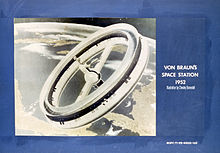Rotating space station

Rotating space stations ( von Braun wheels ) are hypothetical , tire-shaped space stations or spaceships rotating around their own axis , which cause the effect of an artificial gravity through their rotation .
history
The Russian space pioneer Konstantin Tsiolkovsky thought about the possibility of a rotating space station as early as 1903. In 1928 the description of a rotating space station can be found in the book Problem of the Passage of Space by the Croatian-Austrian Herman Potočnik , published in Berlin under the pseudonym Hermann Noordung . It is very likely that the engineer Wernher von Braun, who was working in Berlin at the time, knew the book. Despite his collaborations with the National Socialists, Braun became an important part of the American missile project and, together with Willy Ley , described a corresponding structure in the magazine Collier's Weekly in 1952 .
The 2001 film, Odyssey in Space popularized the idea in 1968; Sometimes the initial idea is even ascribed to the script co-writer Arthur C. Clarke . Since then, rotating space stations have become more common in sci-fi films.
In 2011, NASA presented the Nautilus-X concept . It was a spaceship for long-term missions. Part of the concept was a rotating ring.
The US company Gateway Foundation published the vision of a space station in low earth orbit for up to 1250 guests in the mid-2010s . Under the project name “Von Braun Station”, this concept attracted media attention in 2019. The space station is to be financed through membership fees and the income from a lottery.
Practical experiments (selection)
- 1965: In an unsuccessful experiment, the astronauts on board Gemini 8 were subjected to strong acceleration due to the rotation of their vehicle.
- 1966: Gemini 11 and an Agena target rotated around each other, connected by a rope. The effect was barely noticeable for the astronauts, but it was observable and measurable. Gemini 12 performed a similar experiment a few weeks later.
- 2018: The unmanned German mission Eu: CROPIS used the rotation of a satellite to simulate the gravitational conditions on the moon for experiments on plant growth.
Examples of rotating space stations in literature and film
- 1961: Solaris (novel, Stanislaw Lem)
- 1968: 2001: A Space Odyssey (film and novel, Arthur C. Clarke / Stanley Kubrick)
- 1984: 2010: The Year We Make Contact (Film, Peter Hyam)
- 1985: Ender's Game (Roman, Orson Scott Card)
- 1994: Babylon 5 (TV series).
- 1999: Planetes (Manga / Anime).
- 2000: Mission to Mars (film, Brian de Palma)
- 2013: Elysium (film, Neil Blomkamp).
gallery
Rotating space station; Illustration from Herman Potočnik's The Problem of Navigating Space (1929).
Individual evidence
- ↑ space stations. Dream and Reality (PDF). sfgh.de. Retrieved January 13, 2020.
- ↑ Wernher von Braun: Crossing The Last Frontier. In: Collier's Weekly. March 22, 1952, pp. 24-29 , accessed January 15, 2020 (English).
- ↑ Willy Ley: A Station in Space. In: Collier's Weekly. March 22, 1952, pp. 30-31 , accessed January 15, 2020 (English).
- ^ Patrick Barry: Wheels in the Sky. First Science, 2014, accessed January 13, 2020 .
- ^ What is the gateway . Gateway Foundation, 2016.
- ↑ Planned for 2027. Vacation in space? This is how crazy the first space hotel should look. Star Online . September 23, 2019, accessed January 13, 2020.
- ↑ From Braun Station. gatewayspaceport.com. Retrieved January 13, 2020.
- ↑ Gemini12 Mission Report (PDF) ; Chapters 1-3; accessed on January 19, 2020
- ↑ Compact satellite in polar orbit - Farewell to Mission Eu: CROPIS. DLR, January 13, 2020, accessed on January 19, 2020 .

